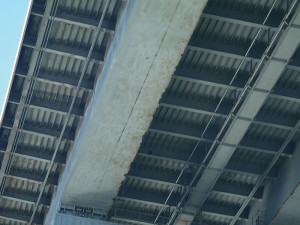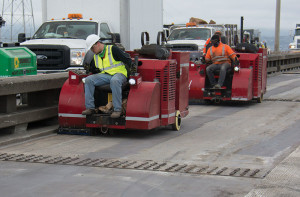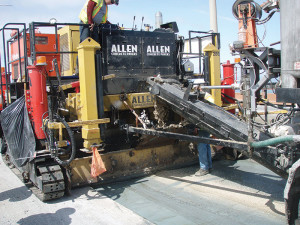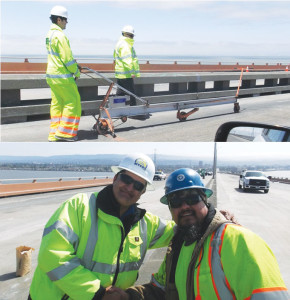Replacing Riding Surface to Maintain Structural Integrity and Durability of an Orthotropic Deck
In 1967, the San Mateo/Hayward Bridge incorporated the United States’ first orthotropic steel bridge deck on a major bridge, winning the American Society of Civil Engineers’ (ASCE) Outstanding Civil Engineering Achievement Award (OCEA). The mile long orthotropic steel deck is included within the six lane wide, two mile long steel high-rise portion of the seven mile long bridge. The two mile high-rise, spanning a navigation channel, was designed per the American Institute of Steel Construction’s (AISC) 1963 Design Manual. The San Mateo/Hayward Bridge is the longest bridge in the San Francisco Bay Area and the 25th longest in the world.
The riding surface placed in 1967 was an epoxy-modified asphalt concrete (EAC), and was now in need of replacement. Replacement materials for the riding surface were narrowed down to the original EAC that had performed so well and a premixed polyester concrete developed by Caltrans that has been performing well on concrete decks since 1983.
One major concern for replacing the riding surface was taking the bridge out of service during installation. This is a critical bridge connecting the East Bay Area communities to San Francisco, which made construction techniques even more important. It was shown that polyester concrete could be more adaptable to placement within tight time constraints.
Construction was performed primarily during two continuous 55-hour shifts over two weekends in May of 2015. The successful bidder was a joint venture of two California-based prime contractors pooling their capital and labor resources so as to focus on completing the tasks of removing the EAC and replacing it with a premixed polyester concrete on six lane-miles of riding surface. Detailed contractor planning and coordination of the vast amount of skilled labor and equipment on the bridge at one time, and owner inspection of the work with material quality assurance testing to ensure manufacturer’s quality control were vital to success. In contrast, the original 1967 surface placement time was three weeks at eight hours per day.
The San Mateo/Hayward Bridge
The bridge consists of a five mile long concrete trestle on the east side, and a two mile long high-rise steel structure over the navigational channel on the west end. Approximately ½ mile on the approach and departure sides of the high-rise consists of steel box girders and a lightweight concrete deck. The center portion, roughly 1 mile long, consists of two steel box girders, floor beams, and a steel deck stiffened with open longitudinal ribs. Welded together they form a composite structure. With the steel deck acting as the top flange for the ribs, beams and girders, this meets the definition of an orthotropic bridge, which is derived from the terms orthogonal meaning having properties at 90 degree angles and anisotropic meaning directionally dependent properties. The steel deck is on the fourteen 292-foot long spans, the main channel span of 750 feet, and the two anchor spans of 375 feet each (Figure 1).

Figure 1. View from under showing ribs, girders and floor beams welded to deck plate.
Need for Riding Surface
Orthotropic steel decks created a need for a riding surface material that bonds well to steel and is capable of conforming to a desired ride quality. It must also protect the steel from corrosion. The 1967 riding surface was an EAC, a thermoplastic asphalt modified with a thermosetting epoxy polymer. Deck sections were field bolted with splice plates requiring a riding surface thickness large enough to cover the bolt heads. This 2.25-inch thick riding surface paved in two lifts was chosen following years of laboratory and field evaluations. After painting the deck with a zinc-rich paint as an added precaution, an epoxy-asphalt bond coat was applied to adhere the riding surface to the steel. The EAC was paved using conventional methods and techniques used for placing a typical asphalt concrete roadway.
The material was strong and tough enough to withstand traffic wear and differential bridge movements, without cracking or de-bonding for 30+ years. By 2002, cracking was observed and in some places the EAC was shoving, indicating it had lost bond. More and more maintenance was required and the potential for deck corrosion increased.
Replacement after Years of Service Life
The requirements for a replacement surface needed to meet the 1967 objectives plus some additional criteria. Bonding to steel has taken on an additional importance since this bridge was designed, as an effective bond between the steel and overlay increases stiffness by composite action thus lowering fatigue stresses in the steel deck. Per AASHTO 2012: “the wearing surface should be regarded as an integral part of the total orthotropic deck system and shall be specified to be bonded to the top of the deck plate…the wearing surface shall be assumed to be composite with the deck plate, regardless of whether or not the deck plate is designed on that basis.” The original targeted minimum bond strength by direct pull out was 200 psi. Much higher bond values are now achievable. Furthermore, accelerated construction to minimize the impact on traffic was now a new criterion.
Laboratory Evaluation
Caltrans initiated a research project with the University of Missouri (U of M), which had previous experience evaluating Missouri DOT’s resurfacing options for the orthotropic Poplar Street Bridge. Caltrans chose two alternatives to be investigated – EAC and the standard/widely used polyester overlay system Caltrans developed for concrete bridge decks. The testing evaluated the following:
1) Fatigue characteristics at the steel/riding surface interface,
2) Structural enhancement the riding surface material provided to the deck that in turn lowers fatigue stresses particularly at welds,
3) Static and dynamic load characteristics, and
4) Structural behavior over a range of ambient temperatures.
The U of M tests were tailored around analytical load/deflection behavior of the San Mateo/Hayward Bridge. The results of the research indicated the polyester concrete would perform as well as EAC. The polyester concrete, having a higher modulus of elasticity, added more structural integrity while being 15% lighter than EAC, which was also an advantage.
One variation of the standard polyester concrete system was the addition of zinc powder to the prime coat, which enabled skipping the zinc-rich paint. The zinc powder conformed to the requirements for zinc powder of zinc-rich paint. Comparing State-specified zinc-rich paint with a zinc-rich polyester prime coat showed similar corrosion protection with samples subjected to a salt spray chamber.
Accelerated Bridge Construction Issues
The greatest advantage of polyester concrete was construction within a tight time constraint. The risk of compromising the material during installation would be greater with EAC than with polyester concrete. EAC is centrally batched and delivered in large dump trucks. Temperature and time restrictions after batching are critical to proper polymerization of the epoxy component, the time/temperature sensitive to ambient temperature. Once batched into a truck, little flexibility in timing for proper placement is available. At any given time, multiple truckloads of EAC are on hand, making any unexpected stop or even just a change in the rate of paving problematic. Additionally, since EAC is batched off site, longer delays would be expected before restarting after an unexpected stop to avoid having even more amounts of potentially compromised material. During EAC construction on the Self-Anchored Suspension (SAS) portion of the San Francisco/Oakland Bay Bridge, to facilitate production rates, the minimum time required before a dump truck could discharge was relaxed. However, this in turn required several more days of cure time to prevent premature damage due to inadequate polymerization of the epoxy component. The EAC specifications used for the SAS orthotropic deck required 48 hours after placement just for cure, when EAC was placed within specification limits for time and temperature. Also, a surface treatment operation was needed to provide friction.
Conversely, a polyester concrete can be batched and mixed by continuous mixer and immediately discharged into a moving paver’s hopper, resulting in no more than the small amount of material in the hopper needing attention at any given time. The paving rate can be easily adjusted since the batching rate is instantaneously proportioned to the paving rate. Since stopping and starting the paving operation is a non-issue due to material integrity, unexpected problems requiring stopping/starting of paving could be easily resolved. Control of the added initiator system (hardener) and accelerators allow for regulating working time and strength gain under very diverse temperature ranges. Such control expedites a traffic-ready surface in as little as 1.5 hours during ambient temperatures ranging from 50-100 degrees Fahrenheit. Quick set time also facilitated construction traffic as work progressed. The surface is textured with tine tools during placement and will last for decades, rendering friction as a non-issue.
Field Evaluations
Experience of other State DOTs was also sought. Portland, Oregon’s Fremont Bridge has an orthotropic upper deck which opened in 1973 with an EAC riding surface. In 2011, the original surface, which is less than 40% of the area of the San Mateo/Hayward Bridge, was removed and a new EAC was placed over several weekend closures. With the cooperation of Oregon DOT, the construction during one of those weekends was observed. This provided direct communication and a first-hand look regarding the risks, anticipated and unforeseen, that ODOT managed. Though Caltrans ended up using a different material, much was learned and incorporated into the San Mateo/Hayward Bridge plans, specifications and estimates for the rehabilitation project. Given Missouri DOT’s relationship with U of M, MoDOT used polyester with the zinc-rich prime coat to repair large sections of the Poplar Street Bridge riding surface that had come loose. The Poplar Street Bridge was completed shortly after the San Mateo Bridge and has been resurfaced several times. MoDOT was more than just pleased with these repairs.
After gaining experience and evaluation of some smaller scale field installations, a small test patch was completed on the bridge, providing an in situ evaluation of the riding surface’s performance. With the success of the test patch, Caltrans set out to replace the aged EAC with polyester concrete. The new riding surface was completed during two weekends in May of 2015.

Figure 2. Deck being shotblasted after removal of old EAC. Note: Transverse bolted splice plate in foreground.
Construction
On Friday, May 8, 2015 at 8 PM, a few lanes were shut down and equipment was moved onto the bridge. At 10 PM, the entire bridge was closed. Tractor trailer dump trucks were lined up on both sides of the high-rise portion of the bridge. With the noise of pavement-breakers, excavators, loaders, and a variety of other heavy and hand equipment, the removal of 11 million pounds of 48 year-old EAC began (Figure 2, page 19). After midnight, loaded volumetric batched mixing trucks rolled onto the deck discharging polyester concrete into the pavers (Figure 3). Just prior, the deck was abrasively cleaned by self-propelled shot blasters followed by hand-held “sand” blasting. The prepared surface was checked for compliance with SSPC-SP 6/NACE. A liberal coat of methacrylate containing 85% by weight of zinc powder was then applied to the surface. Removal, deck preparation, and paving continued on through the weekend – the last of the paving completed shortly after midnight on May 11. A little more than half the bridge was resurfaced and, after clean-up and temporary striping, the bridge was opened prior to the scheduled 5 AM deadline. The process was repeated starting Friday, May 22 and by 3 AM on May 25 the bridge, now with a new riding surface, was opened to traffic.

Figure 3. Continuous mixer/batching truck discharging into paver. Prepared surface has a coating of the methacrylate prime coat containing 85% by weight zinc powder as a corrosion inhibitor.
Eleven volumetric mixer trucks, modified specifically to place polyester concrete, and four pavers modified for the same (no more than two pavers were in operation at any given time) were on hand. Twenty-six tanker trailers, each containing 40,000 pounds of polyester resin meeting all contract compliance tests, were delivered. To ensure a quality material, the supplier supplemented the Quality Assurance testing by Caltrans with additional Quality Control tests, some of which were not even on contractually-required vender properties. Approximately 64,000 pounds. of zinc for galvanic protection are on the deck as part of the prime coat. The surface was tested for compliance with ride quality smoothness by profilograph (Figure 4), while pull off testing indicated nearly 900 psi on 2-inch diameter cores. Friction values were well above the required 0.35.

Figure 4. Top: Profilogragh measurements ensuring contract compliance of quality ride. Bottom: Joint venture contractor foremen crossing paths in middle of bridge. One contractor worked eastbound lanes while the other worked westbound lanes.
With adequate inspection, testing and oversight, coupled with the contractors’ planning and attention to detail, this Accelerated Bridge Construction project was successfully completed without compromise. If the material exceeds its life expectancy, as did the first material, the next replacement and subsequent interruptions to traffic won’t be needed until after the centennial celebrations of the Eisenhower Interstate Highway System.▪
